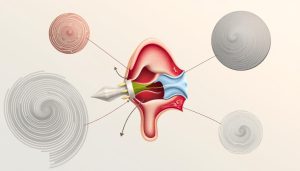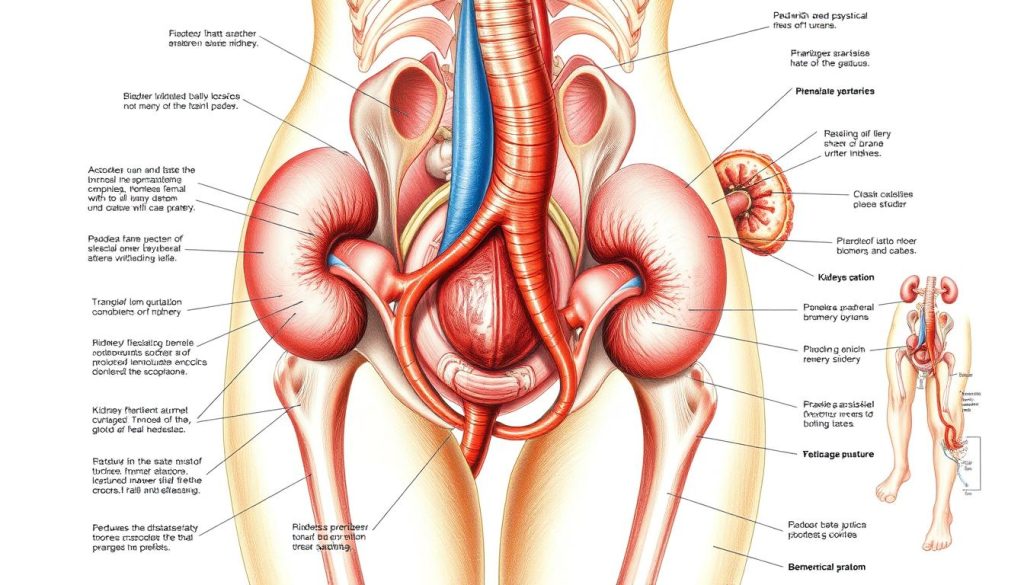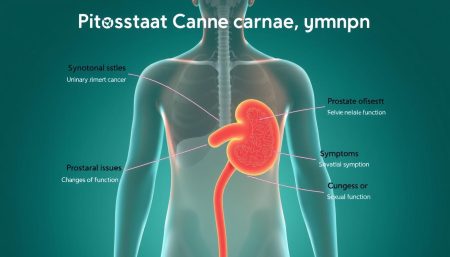Many people wonder if women can get prostate cancer. It’s a common belief that only men can get this disease. But, the truth is more complex. This article will look into the medical facts about female prostate cancer and if women have a prostate gland.
We will look at the differences in male and female urological systems. This will help us understand the truth about female prostate cancer. By knowing about the unique parts of women’s bodies, we can better understand female prostate cancer and related issues.
We will talk about Skene’s glands, also known as the female prostate. We will see if they can get cancer. We will also discuss how to diagnose, treat, and prevent urological cancers in women. This will give important information to those who care about their health and those dealing with these conditions.
Understanding the Anatomical Differences Between Male and Female Urological Systems
The urological systems of males and females are different. These differences are key in the development of certain cancers, like skene’s gland cancer. Let’s look at what makes each system unique and how it affects health.
Male Prostate Anatomy and Function
The male prostate is a walnut-sized gland below the bladder. It makes seminal fluid and is important for reproduction. If it grows too big, it can block the urethra and cause urinary problems.
Female Urological Structure and Skene’s Glands
Women don’t have a prostate but have Skene’s glands, also called the “female prostate.” These glands are by the urethra and make a fluid like male prostatic secretions. Skene’s glands can get sick, including rare cases of cancer.
Comparative Analysis of Glandular Tissues
Male prostates and female Skene’s glands both make fluids, but they are different in size and function. Here’s a comparison:
| Feature | Male Prostate | Female Skene’s Glands |
|---|---|---|
| Size | Walnut-sized | Pea-sized |
| Location | Below bladder, surrounding urethra | On either side of urethra |
| Main function | Produce seminal fluid | Produce lubricating fluid |
| Cancer risk | Common prostate cancer | Rare skene’s gland cancer |
Knowing these differences is key for diagnosing and treating urological problems in both men and women. While prostate cancer in men is well-known, it’s also important to be aware of female urologic cancers and gynecologic malignancies for good healthcare.
Can Women Get Prostate Cancer: The Scientific Truth
Women can’t get prostate cancer like men do. This is because they don’t have a prostate gland. The prostate is a male organ important for reproduction.
But, women have something similar to the prostate. It’s called Skene’s glands, or the “female prostate.” Though rare, these glands can get tumors, which some call “female prostate cancer.”
Skene’s gland tumors are part of rare female cancers. They’re like prostate tissue in men. These cancers are very rare, with only a few cases in medical records.
Skene’s gland cancer is so rare that it’s often misdiagnosed or overlooked entirely.
When doctors talk about “female prostate cancer,” they usually mean Skene’s gland tumors. The symptoms, diagnosis, and treatment are different from male prostate cancer.
Even though women can’t get prostate cancer like men, they can get other urological cancers. It’s important for women to get regular check-ups and watch for any unusual symptoms. This helps in early detection and treatment of these rare conditions.
The Female Prostate: Exploring Skene’s Glands
Skene’s glands, also known as the female prostate, are key to women’s urological health. These small organs near the urethra have raised questions about female prostate cancer and other issues.
Structure and Function of Skene’s Glands
Skene’s glands are small, pea-sized organs by the urethra. They make a fluid that helps keep the urethra moist and might fight off infections. Even though they’re much smaller than the male prostate, they do similar jobs.
Hormonal Influences on Skene’s Glands
Skene’s glands change with hormone levels. Estrogen and testosterone can make them grow or shrink. This is why some women notice changes in these glands during pregnancy or menopause.
Common Conditions Affecting Skene’s Glands
Skene’s glands can face various issues, from mild to serious. These include:
- Skene’s gland cysts
- Infections
- Skene’s paraurethral gland neoplasms
Though rare, female prostate cancer can occur in these glands. Catching it early and getting the right treatment is key to managing these problems.
| Condition | Symptoms | Treatment |
|---|---|---|
| Skene’s Gland Cyst | Painless lump, Discomfort during intercourse | Drainage, Antibiotics |
| Skene’s Gland Infection | Pain, Swelling, Discharge | Antibiotics, Pain relief |
| Skene’s Gland Cancer | Blood in urine, Painful urination | Surgery, Radiation, Chemotherapy |
Understanding Female Paraurethral Gland Tumors
Female urologic cancers are a group of gynecologic malignancies that can affect various parts of the urinary system. One rare but significant type is Skene’s gland cancer. It develops in the paraurethral glands near the urethra.
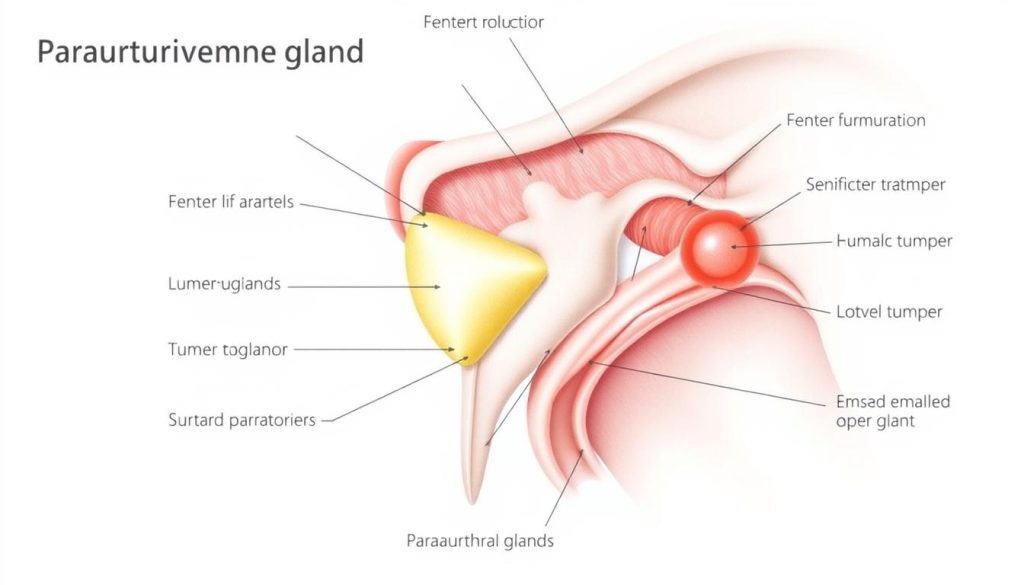
Skene’s glands, also known as lesser vestibular glands, are small structures located on either side of the urethra in women. These glands play a role in lubrication and sexual function. While tumors in this area are uncommon, they can occur and may be benign or malignant.
Paraurethral gland tumors can vary in size and behavior. Some remain small and cause no symptoms, while others grow larger and may lead to discomfort or urinary issues. The exact cause of these tumors is not fully understood, but factors such as hormonal changes and genetic predisposition may play a role.
- Benign tumors: Usually slow-growing and non-cancerous
- Malignant tumors: Cancerous growths that can spread to other tissues
- Cysts: Fluid-filled sacs that may develop in the glands
Diagnosis of Skene’s gland cancer and other paraurethral tumors often involves a combination of physical examination, imaging studies, and biopsy. Early detection is crucial for effective treatment, as with all gynecologic malignancies.
Treatment options for female urologic cancers in this area may include surgery, radiation therapy, or chemotherapy, depending on the tumor’s size, stage, and characteristics. Research into targeted therapies for these rare cancers is ongoing, aiming to improve outcomes for affected women.
Diagnosis and Detection of Skene’s Gland Cancer
Skene’s gland cancer is a rare cancer in women. It’s similar to prostate cancer but affects the paraurethral glands. Finding it early is key to treating it well.
Common Symptoms and Warning Signs
It’s important to know the signs of female prostate cancer. These symptoms include:
- Painful urination
- Blood in urine
- Pelvic pain
- Difficulty emptying bladder
- Recurring urinary tract infections
Diagnostic Procedures and Tests
Doctors use different ways to find Skene’s gland cancer:
- Physical examination
- Urine analysis
- Blood tests
- Cystoscopy
Imaging and Biopsy Techniques
Advanced imaging helps spot rare cancers. The methods include:
| Imaging Method | Purpose |
|---|---|
| MRI | Detailed soft tissue images |
| CT Scan | Cross-sectional body views |
| Ultrasound | Real-time organ visualization |
Biopsy is the best way to confirm cancer. It takes a small tissue sample for a microscope check. This is vital for diagnosing female prostate cancer and other rare cancers.
Treatment Options for Female Urologic Cancers
Women with urologic cancers, like prostate-like gland tumors, have many treatment options. The right choice depends on the cancer type, stage, and health. Let’s look at the main ways to fight these rare but serious cancers.
Surgical Interventions
Surgery is often the first step against atypical gland malignancies. Doctors might take out the affected glands and nearby tissue. This helps get rid of the cancer while keeping urine flow normal.
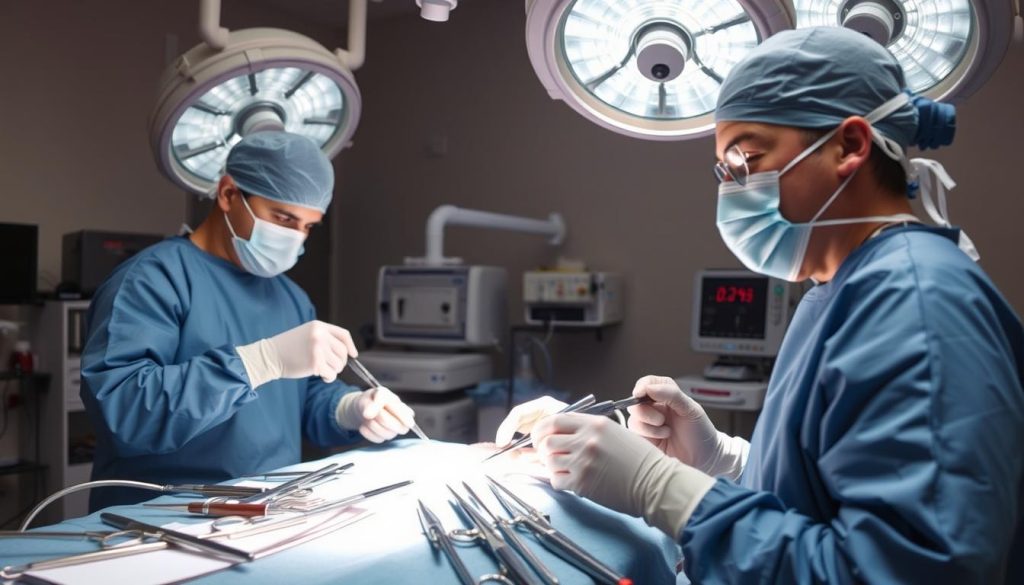
Radiation and Chemotherapy Approaches
Radiation therapy kills cancer cells with high-energy beams. It’s sometimes paired with chemotherapy for better results. This combo can work well against Skene’s paraurethral gland neoplasms.
Targeted Therapies and Clinical Trials
New targeted therapies aim at specific cancer cell traits. These treatments might have fewer side effects. Clinical trials offer new hopes for treatments, possibly improving outcomes for women with prostate-like gland tumors.
| Treatment Type | Description | Potential Benefits |
|---|---|---|
| Surgery | Removal of affected glands | Complete tumor removal |
| Radiation | High-energy beams target cancer cells | Non-invasive option |
| Chemotherapy | Drugs to kill cancer cells | Effective for widespread cancer |
| Targeted Therapy | Attacks specific cancer features | Fewer side effects |
Every treatment plan is unique, made just for the person. Doctors and patients work together to find the best way to fight atypical gland malignancies. This ensures the best quality of life possible.
Prevention and Regular Screening Guidelines
Knowing about female urologic cancers is key for early detection and prevention. These rare cancers can be hard to spot, but regular check-ups are crucial. Women should watch their bodies and tell their doctors about any odd symptoms right away.
Understanding what increases the risk of gynecologic malignancies helps women make better health choices. Things like age, family history, and lifestyle can affect your risk. Eating well and exercising regularly might lower your cancer risk.
Regular screenings are vital in the battle against female urologic cancers. The American Cancer Society offers guidelines for early cancer detection. Even though screenings for rare urological cancers in women are not as common, being alert and talking to a doctor is important. It helps keep you healthy and catches problems early.
By focusing on preventive care and learning about female urologic cancers, women can protect their health. Remember, catching cancer early often means better treatment. So, don’t wait to see a doctor if you notice anything unusual or different.
FAQ
Q: Can women actually get prostate cancer?
A: Women can’t get prostate cancer like men do because they don’t have a prostate gland. But, they have Skene’s glands, also called the “female prostate.” These glands can get rare cancers similar to prostate cancer in men.
Q: What are Skene’s glands and how are they related to the prostate?
A: Skene’s glands, or paraurethral glands, are small near the urethra in women. They’re called the “female prostate” because they work and develop like the male prostate gland.
Q: What types of cancer can develop in Skene’s glands?
A: Skene’s glands can get rare cancers called adenocarcinomas. These are like prostate adenocarcinomas in men but are very rare in women. Other cancers can also happen in this area.
Q: What are the symptoms of Skene’s gland cancer?
A: Symptoms include blood in urine, trouble urinating, pain when you pee, a lump near the urethra, and pelvic pain. But, these signs can mean other things too. So, it’s key to see a doctor for the right diagnosis.
Q: How is Skene’s gland cancer diagnosed?
A: Doctors use a physical check, imaging like MRI or CT scans, and sometimes a biopsy. Urologists and gynecologic oncologists often team up to make the diagnosis.
Q: What treatment options are available for Skene’s gland cancer?
A: Treatment varies based on the cancer’s stage and how far it has spread. It might include surgery, radiation, or chemotherapy. Sometimes, targeted therapies or clinical trials are options too.
Q: Are there any preventive measures for Skene’s gland cancer?
A: There’s no sure way to prevent it, but good urological health and regular check-ups help. Being aware of changes in your urine and seeing a doctor quickly for unusual symptoms is important.
Q: How common are Skene’s gland cancers compared to male prostate cancer?
A: Skene’s gland cancers are much rarer than prostate cancer in men. While prostate cancer is common in men, these cancers are rare in women.
Q: Can hormone therapy used for prostate cancer be effective for Skene’s gland cancer?
A: Hormonal therapies for prostate cancer might be considered for Skene’s gland cancers too. But, because these cancers are so rare in women, treatment is usually customized for each case.
Q: Are there specific risk factors for developing Skene’s gland cancer?
A: Because these cancers are so rare, specific risk factors aren’t clear. But, things that raise the risk of other gynecologic cancers, like age and family history, might play a part.











